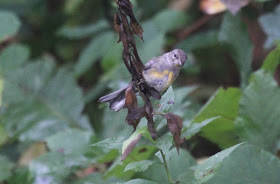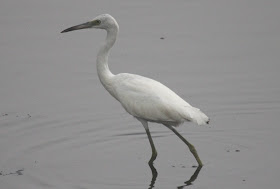It had rained all night, and was still raining hard in the morning. The weather looked like it would break a bit, maybe salvaging the morning. I live only ten minutes from the coast, and as it so often happens, the weather is variable in that short distance. Maybe it wasn't raining at Hammo, or maybe it was raining harder? Even if it was raining at the Park, you could still satisfy your birding appetite by "car-birding" for Shorebirds in the many puddles that develop in the fields and parking lots. Driving down to the Park, it was raining quite hard as I headed south on the Hammo connector. When I approached the Route 1 crossover at the entrance to the Park, it wasn't raining, although the dark sky looked quite ominous to the East.
Felling like I had caught a break, I drove through the Park in the normal routine; checking the western end of the Park first (no Shorebirds) and then the Restoration area (no Shorebirds) and finally the Nature Center parking lot and Meigs Pond and Point (no Shorebirds)! In fact not many birds at all! Deciding to leave for my studio, I was driving around the small circle by Meigs Pond and two Glossy Ibis flew across the road and landed in the marsh. Glossy Ibis are usually gone from the Park in September, so it was a nice morning surprise. The pair was an adult and juvenile and they only stayed for a few minutes. They left as quickly as the rain began; they flew off to the south, and the rain flew in from the east!
A few minutes later I was pulling into my driveway to a mini-fallout of migrants. I managed a few images before it started to pour. Redstart-
Flycatcher species- (anyone have an ideas to the species?)
And there were Pine Warblers everywhere.......
.....including mostly juveniles-
This bird found a prize and then dropped it a few feet away from me-
Sept 5, Hammonasset BSP- After raining all night for the second night, the forecasted clearing was certainly welcomed. I put a coat of primer on a decoy I was working on, which gave me an hour to spare before the second coat. With the two days of nearly steady rain, it might be a good morning for Shorebirds in the Park. Although the tide was low this morning, it was still worth trying. The Park opens at 8:00 am and I was a bit early, so I drove over to nearby Fence Creek. The Creek was busy with stalking Herons and Egrets such as this Tri-colored.....
.....and many juvenile Little Blue Herons......
This Great Blue Heron struggled a bit with the Eel it caught.......
.....but eventually swallowed it-
The always elegant Snowy Egret-
This Yellow-crowned Night-Heron was a proficient Fiddler Crab hunter-
It was 8:oo am, and Hammonasset was quiet; there were no Shorebirds anywhere. I was parked in the Nature Center parking lot waiting for something to happen when it did! A small flock of Shorebirds appeared from the northeast over Clinton Harbor. They flew over the parking lot once and even in the low light and cloudy conditions it was easy to ID them as Lesser Yellowlegs. The flock circled the nearby marsh once and on their second pass I noticed at least one of the birds was a bit different. But beacuse it was only a brief view with very low light conditions and the back-lit birds projectiong only distant silhouettes it was difficult to ID the bird. The flock then flew over the road towards Meigs Pond but never settled. They continued over the beach and kept flying southwest over the Sound. Maybe they flew to the western end of the Park to the puddles? Unfortunately, the puddles were empty.
Black Ducks had begun showing up in the Park, and their numbers have increased lately-
A distant Harrier perches on a snag-
Tree Swallows were feeding over the surface of the Sound-
With the little flurry of Shorebirds a memory, it was time to head back to my Studio. At 4:00 in the afternoon I had painted all day. Again I found myself with an hour to spare waiting for initial paint applications to "tack-up" before I could continue. Thinking about those newly formed puddles at Hammo, it was now high tide, maybe another quick run down to the Park would be worthwhile for maybe a Shorebird or two? When I arrived at the western end of the Park, I was greeted by a puddle full of Shorebirds, and noone there to enjoy them. In the puddles were Lesser Yellowlegs, a few Greater Yellowlegs, Least Sandpipers, and a few Semi-palmated and Pectoral Sandpipers. Were these the same birds I saw that morning? The Shorebirds slowly wandered towards the other side of the puddle and in the middle of a group of Lesser Yellowlegs was a stunning Stilt Sandpiper-
Two other birders showed up and we all enjoyed the Shorebirds in the puddle.
With Pectoral Sandpipers-
Pectoral Sandpipers-
And last but not least......a Least Sandpiper-
After spending a solid hour with the late afternoon gift of Shorebirds, I was home again. After supper and a few more hours of painting, I was thinking about that flock of Lesser Yellowlegs and the one "different" Shorebird in the flock, so I downloaded all the images and started going through them. After cropping a few of the flock shots, it was clear what the "different" bird was. When the images were lightened, it was obvious; the bird was a Stilt Sandpiper, most likely the one from the puddle. But the images also revealed not one, but two Stilt Sandpipers were in the flock of Lesser Yellowlegs (in the line of birds-third from the right and third from the left)-
(Stilt Sandpipers extreme right and bottom left)-
Stilt Sandpiper (center)-
Stilt Sandpipers (fourth from left and extreme right)-
As I reviewed the images below, I discovered that there weren't two Stilt Sandpipers in the image, but three! (Bottom center, center of image above the lower bird, second bird from right in front of the second bird).
(Bottom left, center of image and top right)-
Field marks such as comparable size, feather shapes/colors, wing shapes, bill lengths, etc are all important features when separating species such as Lesser/Greater Yellowlegs and Semi-palmated/Western Sandpipers. Separating flying birds in flocks can be a bit more challenging since often your views are only quick passing looks. To identify Stilt Sandpipers from Lesser Yellowlegs in flight I use simple field marks to separate the two species. Obviously comparing the birds anatomical structure is a most effective way to pick them out of the flock. But that only works for a trained eye and under perfect conditions. My method is based on my artistic understanding of birds.
Since I recreate birds as realistically as possible in wood and paint, it is the birds anatomical structure and features and fine details that I direct my attention to. Besides the subtle differences in the birds overall shape and plumage characteristics, it is the head structure that best separates these two species for me.
The cropped image below is from the feeding Stilt Sandpiper image above in this report. If you look at the head of this bird and compare it to a Yellowlegs, you will see obvious differences that may not seem that way at first. The bill- The bill is heavier overall from its base to the tip which has a very slight downward curve when compared to the thinner tapered straight bill or the Yellowlegs. The head shape- The Stilt Sandpiper's head shows only a slight forehead which angles upward onto its pileum, where a Yellowlegs shows more forehead and a "squarish" head shape. Most important- the Mandibular basal feathering-
(the small triangular patch of feathers that line the base of the bill where it joins the head)- This feathering along the base of the mandible (lower bill) extends more forward (vertically) than the feathering at the base of the maxilla (or upper bill) at the lores of the Stilt Sandpiper. Where as these areas line up vertically on the Lesser Yellowlegs (second image below).
Stilt Sandpiper-
Lesser Yellowlegs-
4)-"Low Tide Dowitchers" and 5)- "Shorebirding and a Visiting White Ibis" continues...........
To Continue- Click on "Older Posts" below right-
Keith Mueller
Killingworth, CT





























































































